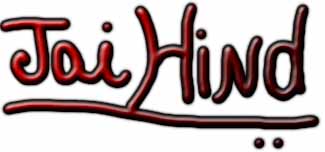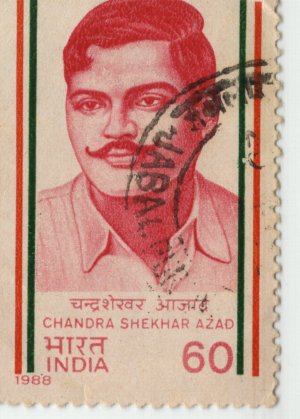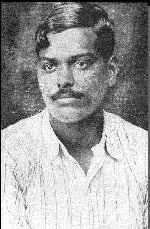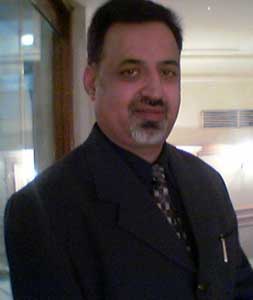Chandrasekhar Azad was born
on July 23,1906 in Badarka(Unnao).Earlier he was Chandrasekhar Tiwari,but
after a court incident he became famous as Azad.Chandrasekhar Azad's parents
were Pandit Sita Ram Tiwari and Jagrani Devi. He received his early schooling
in Bhavra District Jhabua (Madhya Pradesh). For higher studies he went
to the Sanskrit Pathashala at Varanasi. He was an ardent follower of Hanuman
and disguised himself as a priest in a hanuman temple to escape the dragnet
of British in pre-independence India.
Young Azad was one of the
young generation of Indians when Mahatma Gandhi launched the Non-Cooperation
Movement. But many were disillusioned with the suspension of the struggle
in 1922 owing to the Chauri Chaura massacre of 22 policemen. Although Gandhi
was appalled by the brutal violence, Azad did not feel that violence was
unacceptable in the struggle, especially in view of the Amritsar Massacre
of 1919, where Army units killed hundreds of unarmed civilians and wounded
thousands in Amritsar. Young Azad and contemporaries like Bhagat Singh
were deeply and emotionally influenced by that tragedy.
As a revolutionary, he adopted
the lastname Azad, which means "Free" in Urdu.There is an interesting story
that while he adopted the name "Azad" he made a pledge that the Police
will never capture him alive. Azad and others had committed themselves
to absolute independence by any means. He was most famous for The Kakori
Rail Dacoity in 1925 and the assassination of the assistant superintendent
of Police John Poyantz Saunders in 1928. Azad and his compatriots would
target British officials known for their oppressive actions against ordinary
people, or for beating and torturing arrested freedom fighters.
Azad was also a believer
in socialism as the basis for a future India, free of social and economic
oppression and adversity.
Bhagat Singh joined Azad
following the death of Lala Lajpat Rai, an Indian leader who was beaten
to death by police officials. Azad trained Singh and others in covert activities,
and the latter grew close to him after witnessing his resolve, patriotism
and courage. Along with fellow patriots like Rajguru and Sukhdev, Azad
and Singh formed the Hindustan Socialist Republican Association, committed
to complete Indian independence and socialist principles of for India's
future progress.
Betrayed by an informer
on 27 February 1931 Azad was encircled by British troops in the Alfred
park, Allahabad. He kept on fighting till the last bullet. Finding no other
alternative, except surrender, Azad shot himself in the temple
On the 27th of February,
1931 Chandrashekhar Azad met two of his comrades, the names of whom are
highly disputed. However, most people belive that they were a Veer Bhadra
and a Prithvi Raj Azad. Prithvi Raj claims that he was there along with
Veer Bhadra for a briefing on his mission to Russia. The Revolutionaries
of the HSRA or the Hindustan Socialist Republican Association were planning
a revolution in India with the help of the Communists of Russia. He further
states that Veer Bhadra excused himself saying he had an appointment and
left. He had been behaving highly suspiciously for a few days. A few minutes
later a brigade of policemen suddenly fired a shot and had the park surrounded.
Azad asked Prithvi Raj to flee and said that he would continue the fight.
He was injured in his leg. The superintendent asked him to raise his hands
and come out. Next moment he fell to the ground in agony as a bullet ripped
through his arm. The brigade opened merciless fire in the course of which
Azad was badly injured. He himself had already shot at least three policemen
dead and many more were injured. At Alfred Park, behind an ancient tree,
Azad made his last stand, one which would characterise the Indian independence
movement. Till his last breath the soldiers were terrified of his sharp
shooting skills. And this was to be the final stage of a this movement,
the final scene in his life as well as the end of the revolutionaries of
the HSRA. Seeing no way out Azad loaded his last bullet into his Mauser
pistol, it would be the last bullet he ever fired; he would be the last
man he ever killed in the struggle for Indian Independence. Chandrashekhar
Azad put the gun to his temple and shot himself. He had vowed to remain
Azad, meaning free in Urdu, all his life. He said that as long as he had
his bumtulbukara or his pistol no one would ever catch him alive. He said
that he would never be taken to the gallows tied up the way monkeys are,
and made to dance by the British. His favourite couplet and only known
composition is as follows: "Dushman ki goliyon ka hum samna karenge Azad
hee rahein hain, azad hee raheinge!" Years of man hunt, terror, raids,
assassinations and demonstrations had at last ended for the British Raj.
With him all the revolutionaries were finished. The next time the British
would face so grave a problem and so fierce an enemy would be 10 years
later in 1941. There would be a much more developed and well organised
army then lead by none other than the Netaji - Subhash Chandra Bose, an
ardent supporter and sympathizer of Chandrashekhar Azad and Bhagat Singh.
The
Kakori Rail Dacoity.......... |





